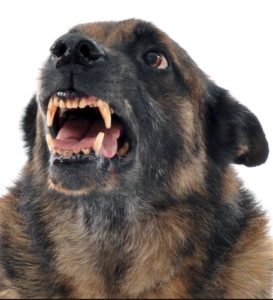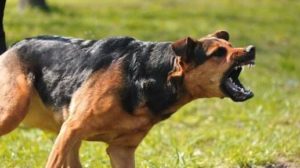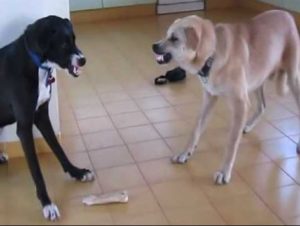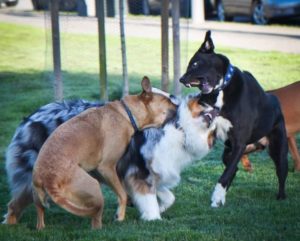What to do about Dog Fights?
Difference Between a Dog Fight and a Dog Scuffle
The first thing to determine is what constitutes a fight. Dogs may scuffle and argue while establishing hierarchy, teaching a younger dog the rules of behavior, curbing over enthusiastic play or just testing the boundaries of an established relationship (such as a young dog testing the authority of the top dog as it ages).
Scuffles may be loud but they are usually short in duration and don’t cause any injuries. However, the one thing that can make a scuffle turn south is an interfering human. Sometimes the best thing we can do is to let our dogs settle the small stuff themselves. Learn to stand back and watch for some moments before interfering.
Fights are a different story altogether. Fights can be bloody and cause injury to both animals involved. Fights are just bad news.
What Sets Off Aggressive Behavior in Dogs?
- Anxiety: Dogs who were not properly socialized as puppies and do not understand the social cues of other dogs will respond with anxiety and/or aggression. They also appear unstable to other dogs who may respond aggressively.
 Resources: Food, toys, favorite dog beds, the couch and you can all be important resources in the eyes of your dog. If the top dog claims the lion’s share of the toys and you redistribute them “fairly” a fight may ensue.
Resources: Food, toys, favorite dog beds, the couch and you can all be important resources in the eyes of your dog. If the top dog claims the lion’s share of the toys and you redistribute them “fairly” a fight may ensue.- Excitement: Try not to generate too much craziness when you play with your dogs. Over the top adrenaline can cause a fight in even the most stable of dog families.
- New Dog: Adding a new dog to the household upsets the hierarchy. There may be just minor scuffles or a major fight as the social order is rearranged.
- A housemate coming back home after illness, dog shows or travel: Different smells and just the excitement of a homecoming can cause enough instability to start a fight. It is usually a good idea to arrange a cautious reintroduction to the pack at home.
- Top dog is ill or dies: The sudden death or loss of health of an established leader of the pack can throw everything into a flux. Younger or lower ranking dogs may see their opportunity to move up and start conflicts.
- Pain: Pain induced aggression can occur when the affected animal strikes out in fear and anxiety,
- Leash Aggression: Some dogs react aggressively on lead either because they fear they will not be able to retreat if needed, they think their owner will back them up or their owner is telegraphing their own anxiety down the lead and unstablizing the dog. Another reason electric dog fences make sense.
- Mother love: Females will always protect their young. Motherly protectiveness may cause them to attack housemates they have previously co-existed with amiably.
- Territory: a normally peaceable dog may become aggressive if a stranger enters his yard.
How to Prevent Aggressive Dog Behavior that Leads to Fights
Aggression is best prevented by good management and early intervention on the part of  the owner. Learn to recognize the signs of aggressive behavior and body language.
the owner. Learn to recognize the signs of aggressive behavior and body language.
- Direct and unwavering stare at the other dog.
- Hackles up
- Stiff and rigid body posture and movement.
- Lowering of the head.
- Growling, raised lips that show the teeth or a tight closed mouth.
- Standing over or raising up of the body next to the other dog.
How to Prevent Dog Fights
- Spay and Neuter. This is the most important advice we can give.
 Socialize your puppy!!! Puppy classes need to start as early as possible, As soon as your puppy has had two in the series of vaccines and has been wormed get them in a controlled environment with other dogs.
Socialize your puppy!!! Puppy classes need to start as early as possible, As soon as your puppy has had two in the series of vaccines and has been wormed get them in a controlled environment with other dogs.- If you get a second dog make it the opposite sex of your current pet. Same sex households have more fights.
- Feed and give treats separately
- Avoid too many dogs in too small of an area. Make sure everyone has a place to get away from each other.
- Allow your dogs to establish a pecking order without interfering. A few growls and scuffles should establish who is boss and what acceptable behavior is. Helpful humans cause a lot of fights.
- Establish a routine and stick to it. Order begets order.
- If you aren’t sure everyone gets along and you can’t be there to monitor, use crates when you’re gone.
- The more dogs you have, the greater the chance of fights.
- Know your breeds. Any dog can fight but if you have a dominant terrier you better adjust your management to fit a feisty personality.
What to Do If a Dog Fight is Already Happening
- DO NOT scream and yell. That just adds to the adrenaline.
- DO NOT put your hands anywhere in the middle of a dog fight. You will get bit.
- First try distraction. Command OFF or LEAVE IT or whatever command you have to stop activity.
- Try an air horn or a shaker can as distraction
- Use a tennis racket, small board or other object to get in between the dogs.
- If that doesn’t work move up to a water hose or commercial citronella spray. Once they are separated get them in different areas of the house until everyone calms down. If you feel it is safe, allow them to calm down in the same room but make certain you act as leader and no new fighting erupts.
- Spend time trying to figure out what set off the fight and how you can change your management to prevent future problems.
- If you aren’t sure what to do…consult your veterinarian for their advice and recommendations for an appropriate trainer.